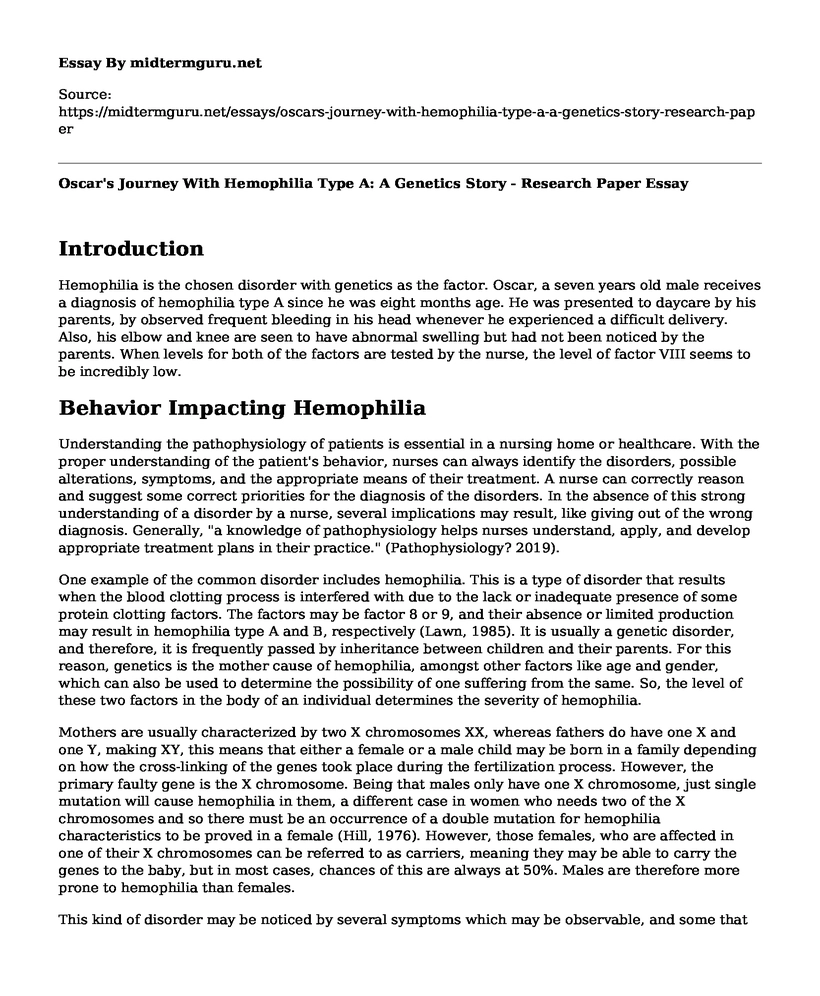Introduction
Hemophilia is the chosen disorder with genetics as the factor. Oscar, a seven years old male receives a diagnosis of hemophilia type A since he was eight months age. He was presented to daycare by his parents, by observed frequent bleeding in his head whenever he experienced a difficult delivery. Also, his elbow and knee are seen to have abnormal swelling but had not been noticed by the parents. When levels for both of the factors are tested by the nurse, the level of factor VIII seems to be incredibly low.
Behavior Impacting Hemophilia
Understanding the pathophysiology of patients is essential in a nursing home or healthcare. With the proper understanding of the patient's behavior, nurses can always identify the disorders, possible alterations, symptoms, and the appropriate means of their treatment. A nurse can correctly reason and suggest some correct priorities for the diagnosis of the disorders. In the absence of this strong understanding of a disorder by a nurse, several implications may result, like giving out of the wrong diagnosis. Generally, "a knowledge of pathophysiology helps nurses understand, apply, and develop appropriate treatment plans in their practice." (Pathophysiology? 2019).
One example of the common disorder includes hemophilia. This is a type of disorder that results when the blood clotting process is interfered with due to the lack or inadequate presence of some protein clotting factors. The factors may be factor 8 or 9, and their absence or limited production may result in hemophilia type A and B, respectively (Lawn, 1985). It is usually a genetic disorder, and therefore, it is frequently passed by inheritance between children and their parents. For this reason, genetics is the mother cause of hemophilia, amongst other factors like age and gender, which can also be used to determine the possibility of one suffering from the same. So, the level of these two factors in the body of an individual determines the severity of hemophilia.
Mothers are usually characterized by two X chromosomes XX, whereas fathers do have one X and one Y, making XY, this means that either a female or a male child may be born in a family depending on how the cross-linking of the genes took place during the fertilization process. However, the primary faulty gene is the X chromosome. Being that males only have one X chromosome, just single mutation will cause hemophilia in them, a different case in women who needs two of the X chromosomes and so there must be an occurrence of a double mutation for hemophilia characteristics to be proved in a female (Hill, 1976). However, those females, who are affected in one of their X chromosomes can be referred to as carriers, meaning they may be able to carry the genes to the baby, but in most cases, chances of this are always at 50%. Males are therefore more prone to hemophilia than females.
This kind of disorder may be noticed by several symptoms which may be observable, and some that may require, testing by the nurses to prove the infection. Individual bleeding in the joints which may be seen by the swelling of ankles, elbows and other joints, traces of blood in either urine or stool, mouth bleeding and gums as well, maybe some of the few symptoms of the disorder.
For a doctor to perform a diagnosis properly, a blood test is essential to determine whether the blood clotting process is functioning out properly. If it doesn't, then a check on the level of clotting factor should be done to diagnose the cause of the bleeding disorder. On the other hand, the disorder can be treated adequately by replacing the missing clotting factor to fix the blood clotting process in the patient.
Most importantly, patients must always ensure that they attend to the hemophilia treatment center (HTC), because the centers usually have many professional nurses who are trained not only to offer effective treatment but also to provide patients with the relevant diagnosis techniques that they can perform by themselves at individual level to prevent or lower the effects of hemophilia in them (Wynn, Slayton & Herzog, 2013).
References
Pathophysiology? W., (2019). What Is Pathophysiology? | LSUA Online. Retrieved from https://online.lsua.edu/articles/healthcare/what-is-pathophysiology.aspx
Wynn, T., Slayton, W., & Herzog, R., (2013). The Need for Gene Therapy for the Effective Treatment of Hemophilia. Journal of Genetic Syndromes & Gene Therapy, S1(02). doi: 10.4172/2157-7412.s1-016
Hill, F., (1976). Handbook of Hemophilia, Parts I and II. Journal of Medical Genetics, 13(5), 416-416. doi: 10.1136/jmg.13.5.416-a
Lawn, R., (1985). The molecular genetics of hemophilia: Blood clotting factors VIII and IX. Cell, 42(2), 405-406. doi: 10.1016/0092-8674(85)90094-7
Cite this page
Oscar's Journey With Hemophilia Type A: A Genetics Story - Research Paper. (2023, Jan 14). Retrieved from https://midtermguru.com/essays/oscars-journey-with-hemophilia-type-a-a-genetics-story-research-paper
If you are the original author of this essay and no longer wish to have it published on the midtermguru.com website, please click below to request its removal:
- Adolescent Pregnancy - Sex Education Essay Sample
- Factors Impacting on Health Care Delivery to Persons With Disabilities - Research Paper Example
- Approach to Cancer Care - Paper Example
- Research Paper on Components of the Brain of Humans
- Research Paper on Insulin Suppression Feedback and p13K Inhibitors
- Cardiovascular Disease Case Study
- Autism: From Refrigerator Mothers to Modern Causes - Essay Sample







